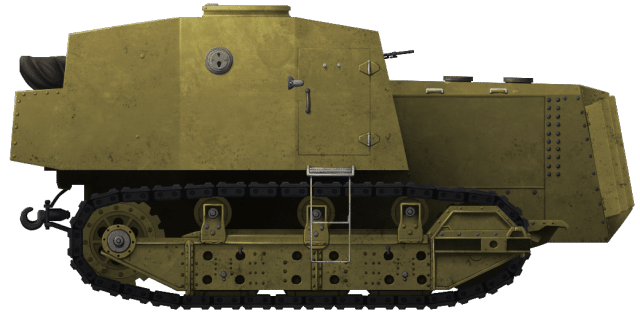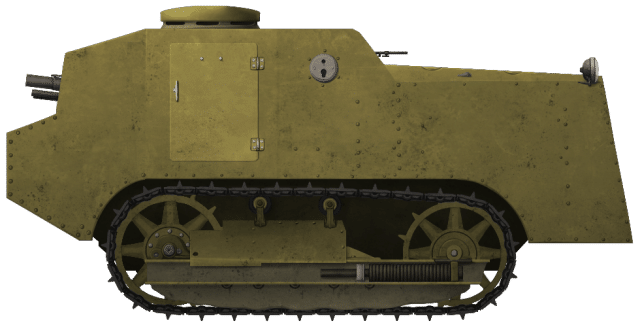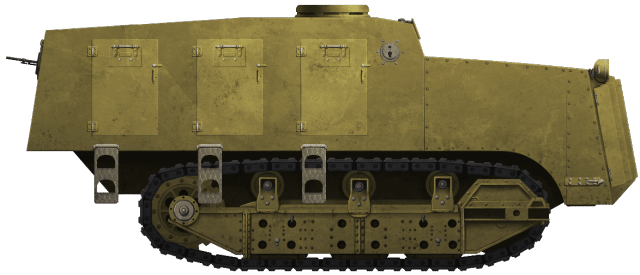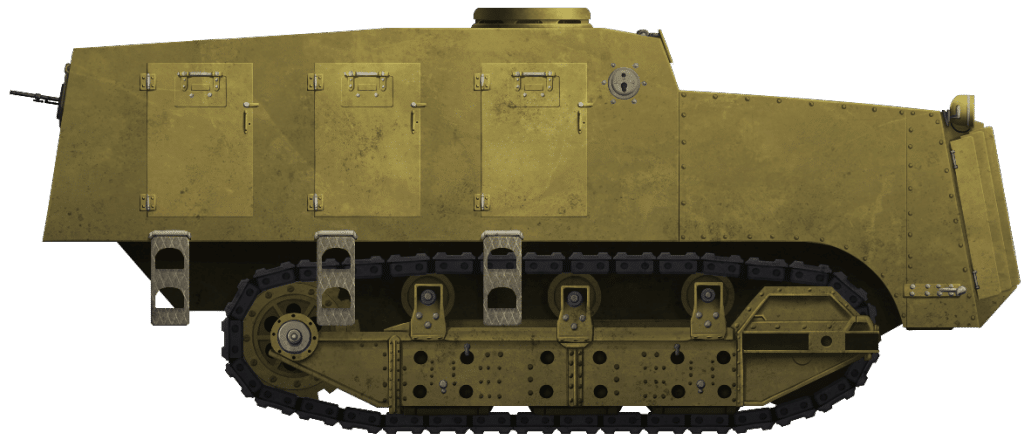 Soviet Union (1931)
Soviet Union (1931)
Armored Tractors – 1 Prototype of Each Built
At the beginning of the 1930s in the USSR, several global interrelated processes were going on. These parallel processes had a severe impact on military effort and procurement.
Firstly, there was a need to re-equip and reform the army, in particular, the armored forces. The armored forces of the USSR mainly consisted of outdated tanks and armored cars, such as the British Mark V and Medium Mark A Whippet tanks or Garford-Putilov armored cars captured during the Civil War, and T-18 (MS-1, Maly Soprovozhdenya) tanks. These vehicles no longer met the needs of the tank units, The Red Army wanted a tank with a more powerful engine, better speed, maneuverability, ergonomics, and installed radios.
Secondly, the country’s leadership realized a serious setback in the industrial field. On July 15, 1929, the program of mechanization and motorization of the Red Army for the next 5 years was approved. By 1933, it was planned to have 3,500 active tanks in the army and another 2,000 in the mobilization reserve. At the same time, the RVS (Revolutsionniy Voenniy Sovet – Revolutionary Military Council, the supreme military authority of the Soviet Union) adopted a new system of auto-armor-tank-tractor armament, which was based on the modern requirements of combat and tactics.
When trying to implement the adopted plans for the development and production of new weapons and military equipment, the industry faced “enormous difficulties.”
Thirdly, both the production and the army suffered from a shortage of qualified personnel. New cadres (specially trained professionals) were not yet ready and did not have enough experience, and a significant part of the old and experienced specialists, for political reasons, were “cut off” from military service and leadership positions.
There were many different causes for rejecting specialists or young recruits “for reasons of political and moral inferiority”, such as affiliation to the “wrong ”class (bourgeoisie, clergy etc.) or professional backgrounds — service in the White Army or administration of the Russian Empire.
The military leadership, however, followed the global trends in the field of armaments and tactics and tried to keep up with them. At this time, new military theories were actively developed.
One of these theories was developed by the Soviet military theoretician and Marshal of the Soviet Union Mikhail Nikolayevich Tukhachevsky. According to that theory, simple and cheap armored tractors could be used as tanks of the 2nd and 3rd echelons (troops and armor of the 2nd and 3rd lines in a formation), even at the expense of reducing important combat characteristics.
“… we need to strive to have military tanks in numbers up to about one-third of the total, to perform special tasks, fight against anti-tank artillery, etc. The remaining tanks, usually advancing in the 2nd and 3rd echelons, can have somewhat lower speed, larger size, etc. And this means that such a tank can be an armored tractor, just as we have armored cars, trains and railcars, which will allow us to field armored tractors in huge masses.”
The Red Army required a large number of inexpensive, easy to manufacture and operate combat vehicles. The latter was especially important due to the acute personnel shortage – Soviet military theorists understood that the skills of the available manpower were not sufficient in the early 30s, and in the event of a major war, they would not have time to train qualified soldiers to man complex military equipment.
The Experimental Design Office of the Department of Mechanization and Motorization of the RKKA (UMM RKKA – Department of Mechanization and Motorization, Upravlenie Mekhanizacii I Motorizacii) was instructed to develop a “tractor tank”, like the American dual-purpose machine, the six-ton tractor Disston.
Most likely, the information about the Disston tanks was obtained from mass-media or during the so-called “Khalepsky Commission” visit to the USA. At that time, Nikolai Ivanovich Dyrenkov, a talented and extremely ambitious self-taught engineer, headed the Department of Mechanization and Motorization of the Red Army. Under his leadership, at the end of 1930, the development of so-called “surrogate tanks,” an infantry transporter and a number of other vehicles, began.
Development
The “Kommunar” tractor, a licensed version of the German tractor Hanomag WD50, was taken as the basis for the D-10 and D-14, and the American Caterpillar-60 tractor was taken as the basis for D-11.
The production of “Caterpillar-60” was planned to start in Chelyabinsk (a city east of the Ural Mountains, which became a very important transport hub and industrial center during 1930s). “Kommunars” were already in production in Kharkov.
The Department of Mechanization and Motorization of the Red Army was charged with building prototypes of so-called “surrogate tanks”: D-10, D-11, APC D-14 (“desantniy tank”). In Russian, the word “desant” is often used for troops which ride into the battle on top or inside the armored vehicles. Thus – “desantniy tank”. The same word is used for airborne troops – “vozdushno desantniye voyska”) and the D-15 “chemical tank”. All vehicles were created in the Moscow MOZEREZ plant (Moscow Railway Repair Plant, Moskovsky Zheleznodorozhny Remontny Zavod). By February 1931, they were ready.
Design
The design of all three vehicles was approximately the same: an engine was located in the front and, behind it, in the middle and aft part of the hull, there was a crew compartment, combined with a fighting compartment or compartment for troops. A fuel tank was also at the back.
On the roof of the fighting compartment there was a fixed commander’s cupola with viewing slots. Neither of the three vehicles had a rotating turret.
Armament
The D-10 and D-11 surrogate tanks were equipped with a 76.2 mm cannon on a pedestal mount as a primary weapon and two 7.62mm DT (Degtyaryov Tankovy) machine guns in the front and aft armor plates, as an auxiliary armament. Two more spare DT machine guns were stowed in the fighting compartment. There were two ball mounts for additional machine guns on each side armor plate. Worth noting is that the main gun mount was placed in the aft of the tank. In fact, this solution was the same as that of the Garford Putilov armored vehicles.
In the case of the Garford-Putilov, this decision was reasonable because the armored car had two driver positions and often went into battle ‘backwards’, but it was a significant flaw for the armored tractor, since it has to be turned around to fire the main gun.
According to some records, the ammunition did not fit into the tank and it was supposed to be carried on a towed trailer, but there is no information about the trailer itself. The D-14 APC was armed with two DT machine guns – one in the bow and one in the aft ball mounts.
Crew
The D-10 and D-11 tanks had a crew of 3 men – commander, driver, and gunner. D-14 APC had a crew of 2 men – driver and commander.
It is difficult to imagine how the engineers behind the design saw the distribution of crew duties between just two people. It can be assumed that firing was possible only after the vehicle stopped, so the driver or commander could take gunner positions.
Armored Hull
All three vehicles had riveted hulls made of rolled armor plates. The D-14 had three doors on each side of the hull used for the entrance and exit of the crew and dismounts. The D-10 had one door on each side; on the left side, the door was closer to the stern, on the right, to the aft. The D-11 had one door in the middle of each side.
A distinctive feature of all three armored vehicles was a massive armored engine in the front, which blocked visibility for the driver and made it difficult to fire a machine gun.
Engine
Propulsion was provided by a water-cooled four-cylinder, four-stroke engine with a carburetor and a vertical arrangement of cylinders. Kommunar 9GU and Kommunar 9EU had a 75 hp (55 kW) 4-cylinder petrol engine, and Caterpillar-60 had a 60 hp (45 kW) 4-cylinder gasoline engine.
Chassis and Suspension
All 3 vehicles used reinforced tractor chassis’ used as a basis with minimal changes. Transmissions were the same as on the original tractors. The D-10 and D-14 had a spring suspension with two springs for each bogie. The D-11 had a semi-rigid suspension.
Trials and Results
In 1931, all three vehicles were tested at the NIABT Test Site (Nauchno Ispytatelny Avtobronetankovy Poligon, Scientific armored vehicle proving ground in Kubinka, also NIABP). Most likely, the tests of all three vehicles (D-10, D-11 and D-14) were conducted in May-June 1931. This fact is confirmed by the document with the preliminary test results dated July 1931.
On July 18, 1931, the Scientific-Technical Committee of the UMM RKKA considered a report on the testing of three vehicles: a “Kommunar 9GU” armored tractor (D-10 tank), a “Kommunar 9EU” armored tractor-infantry carrier (D-14 APC) and an armored tractor “Caterpillar 60” (D-11 tank).
D-10 Tank
The total weight of the tank exceeded by 1.5 tonnes the original projection. As a result, the average speed and mobility decreased. Instead of the estimated speed of 7-8.5 km/h on roads and 5-6 km/h off-road, the tractor-tank showed 6-6.2 km/h on roads and only 3.2 km/h off-road. When the outside air temperature was above 15 °C and the radiator was closed, the water boiled after 1-1.5 hours of the engine being in use.
Obstacle overcoming tests were unsatisfactory. The tractor-tank coped with a 1.25 m wide and 1 m deep trench dug in sandy soil, which was no worse than MS-1 tank. But the vehicle did not cope with a 1.5 m wide trench. D-10 could cross, tear or crush barbed wire barriers only if the stakes did not fall between the tracks, because the bottom of the tank was not protected by armor.
The report also mentioned the fact that the engine could not be started from inside the tank and the absence of a vacuum apparatus for supplying fuel, both considered to be further negative aspects of the armored tractor. The D-10 had a ‘gravity fuel feed’, so if the tank got in an unfavorable position, for example, when crossing the trench, the fuel supply to the engine would be interrupted and the armored tractor would stop. It should be noted that the problem was old, and known since the days of the British Mark I Tank.
The following two problems were distinctive for most Soviet armored vehicles of the 1930s-40s. First, the tests showed difficulties with visibility due to the inconvenient location of the viewing slits. This applied, in particular, to the driver’s position. Secondly, it was noted that there was a lack of ventilation in the crew compartment.

Front view of a D-10 with the D-11 in the background. Source: RGVA

Right side view of the D-10. Source: Domestic armored vehicles. XX century

Left side of the D-10. Source: Domestic armored vehicles. XX century
D-14 Troop Carrier
The weight of the tank, as in the case of the D-10, was exceeded, this time by 2 tonnes. Due to the increased length of the hull, the load on the rear bogies was also increased; as a result, these bogies collapsed during the tests. Problems with the visibility and fuel supply were similar to those of the D-10.
There was also a problem with ventilation, although, in the case of an infantry carrier, it was more acute. According to the designer’s idea, the transporter was supposed to fit 18 riflemen (dismounts) with weapons, plus the crew, since the compartments for crew and dismounts were combined.
Poor ventilation made the conditions inside the APC such that after a few hours of being inside the vehicle, the soldiers and crew would be unable to perform their duties due to heat, cramped space and noise.
The engineer who designed the D-14 placed the doors for entering and exiting the armored tractor on the sides of the hull, with 3 on each side. The doors opened backward in relation to the nose of the vehicle. There were no hatches or doors in the stern. This decision made exiting the vehicle quite dangerous, as soldiers could not hide behind either the doors or the hull of the APC and would be exposed to enemy fire.
Subsequently, the number of troops carried decreased. Later Soviet experimental armored personnel carriers were designed for 14 (TR-1) and 15 riflemen (TR-4). For comparison, the crew of the French Lorraine 38L consisted of 12; driver, commander and 10 infantrymen – four in the troop compartment and another 6 in the armored trailer. It is noteworthy that the exit of the troops through the side hatches or doors returned to the Soviet APCs in the 60-70s, namely the BTR-60P and BTR-70.

Front view of the D-14. Source: Domestic armored vehicles. XX century

D-14 Prototype. Side doors and engine starting handle are clearly visible. Source: RGVA

Rear view of the D-14. Source: Domestic armored vehicles. XX century

Illustration of the D-10 Tank (armored tractor) based on the “Kommunar 9GU” tractor.

Illustration of the D-11 Tank (armored tractor) based on the “Caterpillar 60” tractor.

Illustration of the D-14 Troop Carrier (armored tractor) based on the “Kommunar 9EU” tractor.
These illustrations were produced by Andrei ‘Octo10’ Kirushkin, funded by our Patreon Campaign
D-11 Tank
As in the case with the D-10 and D-14, the weight of the vehicle was exceeded by 2.7 tonnes with similar consequences. The speed dropped to 4.7 km/h on roads and 3.9 km/h off-road. In addition to the familiar problems of D-10 and D-14 with fuel supply and engine overheating, the D-11 had its own unique ones.
According to test engineers, the armored hull was attached to the chassis extremely poorly. Firstly, the hull blocked access to the most important parts of the tractor, such as rear axle and gearbox. Secondly, during the tests, the armored hull of the tank tore off the bolts that attached it to the tractor and fell on the tracks.
Additional problems were reported: poor ventilation – during movement, “dust filled the crew compartment”. When trying to cross a trench, the tractor-tank “sticks the nose into the ground”.
It is not known whether this was a distinctive feature of this particular machine (which was the one based on the Caterpillar 60), or if it was also the case on the machines based on the “Kommunars”. In addition, D-11 has a reduced off-road capability in comparison with D-10 and D-14, because of the shorter base. The report noted a reduced cross-country capability and reduced mobility of this vehicle compared to the D-10 and D-14.

Left side view of the D-11. Source: Domestic armored vehicles. XX century
Test Results and Recommendations
On August 6, 1931, the test results were confirmed in another document, where conclusions and recommendations were presented.
General conclusions were as follows:
- “Surrogate tanks” were not suitable for clearing barbed wire fences due to unarmored bottom. Adding armor to the bottom meant increasing the weight, which means a decrease in the combat performance of already heavy and slow vehicles. In the second document, the general conclusion was much harsher: “nullifies the combat use of this type of armored vehicle”;
- The speed and maneuverability were considered insufficient, even for tanks of the 2nd to 3rd echelons. The chairman of the Scientific and Technological Committee UMM, Ivan Andrianovich Lebedev, noted that the average speed being “less than 4 km/h”;
- Suspension elements were destroyed or worn out due to the excessive weight of the vehicles;
- The artillery armament with which it was equipped was deemed unsatisfactory;
There was another important point that influenced the decision. It was considered that the “Kommunar” tractors surpassed the “Caterpillar-60” capabilities. But, firstly, “Kommunars” were produced by the KhPZ factory (Kharkov Locomotive Factory) in quantities that barely met the needs of the army in tractors for towage of artillery and other weapons. Secondly, the production at KhPZ was, in fact, custom-made. There was no exchangeability of parts even within the same series of machines.
The conclusion for Dyrenkov was disappointing: according to Lebedev, the main purpose of these tractors was towing artillery, therefore it was recommended to remove the armored hulls and convert the surrogate tanks D-10 and D-11 into self-propelled guns and test them.
In the case of the infantry transporter D-14, the UMM committee decided to retest it in order to “obtain more detailed data, both from the technical and from the tactical side.” Alterations included reduction of the troop compartment to 12 soldiers instead of 18. The rear part of the armored hull had to be partly cut off in order to reduce the load on the rear rollers.
In general, it was recommended to reduce the weight of the machine to 10 tons. To achieve this, it was proposed to remove or lighten individual armor plates. And, finally, to install an additional fuel tank, with the ability to pump fuel from the main fuel tank. Lebedev noted that “it is not possible to get a surrogate tank, even with reduced combat capabilities, without a major overhaul of the design.” In fact, it was easier to design a new tank.
Conclusion
Dyrenkov managed to create in 1931 armored vehicles that had the flaws of tanks of the Great War. The Red Army quit experiments with armored tractors but returned to them as an emergency measure in early 1941.
There was a plan to charge the faculty of mechanization and motorization of the Red Army to develop a personnel carrier on the chassis of the tank MM-1 (aka TMM-1, based on the Vickers Mk. E), as it was one of the most robust and common tanks of the Red Army. Further experiments with armored personnel carriers continued and the next attempt was the TR-1 (TR-26) transporter based on the T-26 tank. Nevertheless, the Red Army entered World War Two without any indigenous APC.
As for Dyrenkov and Tukhachevsky, they were both arrested and executed in 1937 during the “Great Purge”.
Specifications (D-10) |
|
| Total weight, battle ready | ~ 12,000 Kg |
| Crew | 3 |
| Propulsion | 4-cyl petrol, 75 hp (55 kW) |
| Maximum speed | 6-6.2 km/h forward, 3.2 km/h reverse |
| Range | 120 km on road |
| Armament | 1 x 76-mm gun M1913 on Garford mount; 1 x 7.62-mm DT machine gun |
| Armor | Front – 16 mm; Back – 16 mm; Sides – 11 mm, Top – 6 mm |
| Production | 1 |
Specifications (D-14) |
|
| Total weight, battle ready | ~ 12,500 Kg |
| Crew | 2 + 18 passengers |
| Propulsion | 75 hp (55 kW) engine |
| Maximum speed | 6 km/h forward |
| Range | 120 km on road |
| Armament | 2 x 7.62-mm DT machine gun |
| Armor | Front – 11 mm; Back – 11 mm; Sides – 11 mm, Top – 6 mm |
| Production | 1 |
Specifications (D-11) |
|
| Total weight, battle ready | ~ 13,250 Kg |
| Crew | 3 |
| Propulsion | 60 hp engine |
| Maximum speed | 4.7 km/h forward, 3.9 km/h background |
| Range | 100 km on road |
| Armament | 1 x 76-mm gun M1913 on Garford mount; 2 x 7.62-mm DT machine gun |
| Armor | Front – 16 mm; Back – 11 mm; Sides – 11 mm, Top – 6 mm |
| Production | 1 |
Sources
RGVA f. 31811 (Russian State Military Archive (Rossiiskii Gosudarstvenni Voennyi Arkhiv- RGVA)
Domestic armored vehicles. XX century: Scientific publication: In 4 volumes / Solyankin A.G., Pavlov M.V., Pavlov I.V., Zheltov I.G. / Vol 1. Domestic armored vehicles. 1905-1941 – M .: Exprint Publishing Center, LLC, 2002. – 344 pp. Ill., P. 61, pp. 88-89
Domestic Armored Vehicles 20th Century Vol 1 1905-1941 (Solyankin 2002)
Tukhachevsky / Boris Sokolov. – M: Molodaya Gvardiya, 2008. – 447 [1] s: il. – (Life of remarkable people: ser. Biogr .; issue. 1104)
Kirindas A.M. “Artillery tractor“ Comintern””, – Moscow: Yauza-Catalog, 2017
A.Bezugolny. “The Source of additional power of the Red Army …”, Moscow: ROSSPEN, 2016
Red Army Auxiliary Armoured Vehicles, 1930–1945 (Images of War), by Alex Tarasov
If you ever wanted to learn about probably the most obscure parts of the Soviet tank forces during the Interwar and WW2 – this book is for you.
The book tells the story of the Soviet auxiliary armor, from the conceptual and doctrinal developments of the 1930s to the fierce battles of the Great Patriotic War.
The author not only pays attention to the technical side, but also examines organizational and doctrinal questions, as well as the role and place of the auxiliary armor, as it was seen by the Soviet pioneers of armored warfare Mikhail Tukhachevsky, Vladimir Triandafillov and Konstantin Kalinovsky.
A significant part of the book is dedicated to real battlefield experiences taken from Soviet combat reports. The author analyses the question of how the lack of auxiliary armor affected the combat efficacy of the Soviet tank troops during the most significant operations of the Great Patriotic War, including:
– the South-Western Front, January 1942
– the 3rd Guards Tank Army in the battles for Kharkov in December 1942–March 1943
– the 2nd Tank Army in January–February 1944, during the battles of the Zhitomir–Berdichev offensive
– the 6th Guards Tank Army in the Manchurian operation in August–September 1945
The book also explores the question of engineering support from 1930 to the Battle of Berlin. The research is based mainly on archival documents never published before and it will be very useful for scholars and researchers.



3 replies on “Dyrenkovs Armored Tractors (D-10, D-11, D-14)”
This thing looks a lot like the Bob Semple. Although compared to the Kiwis, the Russians obviously did a better job in making a tank out of a tractor
Does anyone have a photo or a drawing of the D-15 “chemical tank”?
So far a text description only. But we hope to recover those photos from the archive soon. Stay tuned!